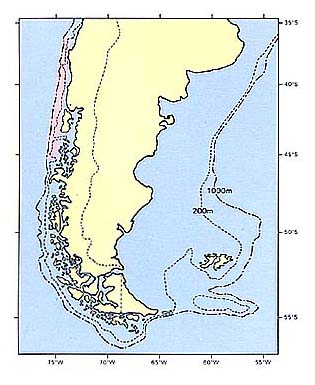シマガツオ科
- HOME
- デジタル図鑑
- パタゴニア海域の重要水族
- 硬骨魚綱 スズキ目
- シマガツオ科
シマガツオ科(Bramidae)

79 ヒレナガシマガツオ(Hirenaga-shimagatsuo)
Brama dussumieri Cuvier, 1831
特 徴:
背鰭32〜35軟条,臀鰭25〜28軟条,胸鰭19〜22軟条,腹鰭5軟条,鰓耙数4〜6+1+12-13=18-20,鰓条骨数7,側線鱗数65〜70,脊椎骨数14-17+24-27=40-43。頭長は体長の28.4-30.1%,体高は41.2〜46.0%,吻長は8.3〜8.8%,両眼間隔は9.3〜10.5%,上顎長は14.6〜15.6%,尾柄高は6.3〜6.9%,胸鰭は36.2〜41.2%,腹鰭は10.2〜11.4%,背鰭高は19.7〜22.3%,臀鰭高は11.6〜12.8%。体長は高く,著しく側扁する。吻は短く,鈍。鼻孔は一対,前鼻孔は丸く,眼窩前縁よりも吻端にわずかに近く位置する。後鼻孔は裂孔状で,前鼻孔と眼窩前縁の中間に位置する。眼は楕円形で,横軸は縦軸よりわずかに短い。主鰓蓋骨と前鰓蓋骨の遊離縁はゆるやかに湾曲し,棘を有しない。鰓条骨は,口を閉じた場合,鰓蓋膜でおおわれる。鰓耙は瘤状で,内側に微小棘を有する。口は中庸で,斜位。上顎後端は眼の中央下に達する。上顎に微小な鋭い円錐歯の歯帯が発達し,外側歯の方が大きい。下顎の歯は1列に不規則に並ぶ。上顎先端の内側に1〜2本の大きな犬歯がある。頭は大きく,体長は頭長の約3.5倍。背鰭基底は長く,前端部は高い。臀鰭前端部は高くない。胸鰭は長く,頭長は胸鰭長の約2.5倍。腹鰭は短く,胸鰭の1/3よりも短い。吻部,下顎,前上顎骨,前鰓蓋骨後半部,各鰭の先端部は無鱗。頭部と体部はやや不規則な大きな円鱗でびっしりとおおわれる。側線はあるが不明確。
分 布:
世界中の熱帯域を中心に分布する。
備 考:
鰓耙数3〜5+1+8〜11=13〜15,鰓孔上縁から尾鰭中央鰭条基底までの鱗数57〜65,側線鱗数65が本種に対して与えられている(Mead, 1972)。
(中村 泉)
Material examined:
10 from Chile (240.1-315.0 mm SL), FAKU CP 178-182, 274, 481-583, 851.
Description:
D 32-35; A 25-28; P1 19-22; P2 5; GR 4-6+1+12-13=18-20; BR 7; LLS 65-70; V 14-17+24-27=40-43.
HL 28.4-30.1% of SL; BD 41.2-46.0; SN 8.3-8.8; IO 9.3-10.5; UJ 14.6-15.6; CP 6.3-6.9; P1L 36.2-41.2; P2L 10.2-11.4; DL 19.7-22.3; AH 11.6-12.8.
Body deep, extremely compressed. Snout blunt, short. Two nostrils, anterior nostril round and slightly closer to tip of snout than to anterior edge of orbit; posterior nostril slit-like and situated midway between anterior nostril and anterior edge of orbit. Eye elliptical, horizontal axis slightly shorter than vertical. Free edge of preopercle and opercle evenly round and without spines. Branchiostegal membrane completely covered with opercular flap when mouth closed. Gill-rakers of usual lath-like shape on first arch, bearing fine spines along inner edge. Mouth oblique, moderate in size, posterior end of upper jaw extending below center of eye. Small sharp conical teeth in bands, those of outer rows larger on upper jaw. Teeth on lower jaw in an irregular row. Upper jaw with one or two enlarged canines inside on anterior tip. Head large, about 3.5 times in SL. Dorsal fin with prominent anterior lobe. Anal fin without prominent lobe. Pectoral fin long, about 2.5 times in head. Pelvic fin short, less than one-third of pectoral fin. Snout, lower jaw, premaxilla, posterior part of preopercle, distal tips of dorsal, anal and caudal fin rays, and most part of paired fins naked. Body and head covered with irregular shaped cycloid scales. Lateral line present, but indistinct.
Distribution:
Worldwide, circumtropical.
Remarks:
Number of gill-rakers: 3-5+1+8-11=13-15; Scales in horizontal series between upper end of gill-cleft and base of central caudal fin rays: 57-65; LLS: 65 for this species by Mead (1972).
(Izumi NAKAMURA)

Distribution of Brama dussumieri in Patagonia.
- 1